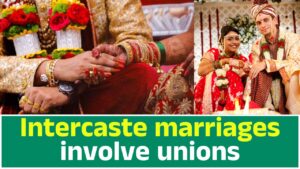Intercaste Marriage Schemes
Introduction to Intercaste Marriages
Intercaste marriages involve unions between individuals from different social or cultural backgrounds, challenging traditional caste-based norms. These marriages are seen as a pathway toward equality and inclusivity. To promote such unions, governments and organizations have introduced various intercaste marriage schemes offering financial and social support.

Historical Context
India’s caste system, deeply entrenched in its societal structure, has historically emphasized endogamy (marrying within one’s caste). However, education, urbanization, and modernization have contributed to the gradual rise of intercaste marriages, offering a means to challenge caste-based discrimination and promote social harmony.
Objectives of Intercaste Marriage Schemes
The primary goals of these schemes include:
- Promoting Equality: Encouraging societal integration by breaking caste barriers.
- Reducing Discrimination: Addressing prejudices and biases against intercaste unions.
- Enhancing Social Unity: Fostering inclusive communities by promoting diverse marriages.
Major Intercaste Marriage Schemes in India
- Dr. Ambedkar Scheme for Social Integration Through Intercaste Marriages:
- Overview: A flagship initiative by the Ministry of Social Justice and Empowerment offering financial incentives, particularly for marriages involving Scheduled Castes (SCs).
- Eligibility: Requires at least one spouse to belong to the SC community and marriage registration.
- Benefits: Includes financial grants, housing support, and assistance in livelihood creation.
- State-Specific Schemes:
- Tamil Nadu: Provides financial support and gold for intercaste couples.
- Maharashtra: Annasaheb Patil Intercaste Marriage Scheme offers monetary assistance.
- Karnataka: Couples receive financial grants and priority in housing schemes.
- NGO Contributions: Non-governmental organizations provide counseling, legal aid, and societal support to intercaste couples, helping them overcome social resistance.
Eligibility and Application Processes
- Eligibility Criteria: Includes caste verification, age requirements, and marriage registration.
- Application Steps: Applicants must submit necessary documents, such as caste certificates, proof of marriage, and bank details.
- Simplified Processes: Governments aim to streamline procedures through online platforms and e-governance.
Success Stories
Real-life examples demonstrate how intercaste marriage schemes have transformed lives by providing financial stability and fostering societal acceptance. Beneficiaries often highlight improved educational opportunities for their children and greater social harmony as key outcomes.
Challenges and Criticism
- Societal Resistance: Families and communities often oppose intercaste unions due to traditional mindsets.
- Administrative Issues: Delays in fund disbursement and application processing hinder the schemes’ effectiveness.
- Misuse of Schemes: Some individuals exploit the schemes without genuine intercaste integration.
Strengthening the Schemes
To improve their impact, measures such as awareness campaigns, simplified procedures, and community engagement are essential. Educational initiatives can play a pivotal role in reshaping societal attitudes toward intercaste marriages.
Global Comparisons
Countries like Nepal and South Africa also promote intercultural marriages through similar initiatives. India can adopt best practices from these nations to further enhance its policies.
Societal Impact
Intercaste marriages contribute to:
- Reduced Inequality: Diminishing caste-based disparities.
- Gender Equality: Empowering women by providing financial independence.
- Social Cohesion: Building a more unified society free of caste prejudice.
Financial Aspects
Governments allocate significant budgets to these schemes, ensuring proper disbursement mechanisms to support beneficiaries effectively. Digital platforms are increasingly utilized to simplify application processes and improve accessibility.
Role of Technology
Digital platforms and matrimonial apps facilitate intercaste unions by connecting individuals across caste lines. Online applications for schemes make processes more efficient and accessible.
Future Vision
Policymakers must focus on improving awareness, streamlining administrative processes, and addressing societal resistance. Education and community sensitization are key to ensuring long-term success in promoting intercaste marriages.
Conclusion
Intercaste marriage schemes represent a progressive step toward dismantling caste barriers and promoting equality. By addressing societal challenges and enhancing the implementation of these initiatives, governments and communities can foster a more inclusive and harmonious society. While challenges persist, these schemes are crucial in ensuring that love transcends caste constraints.
